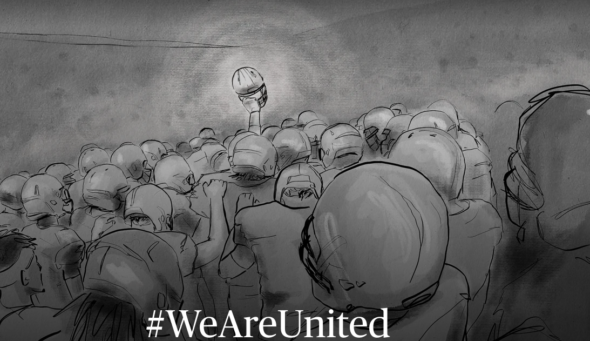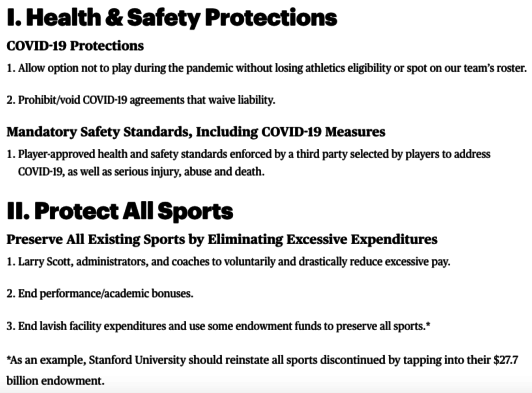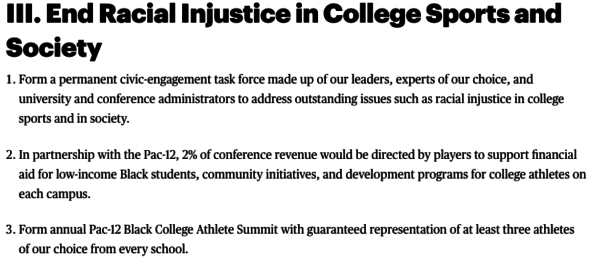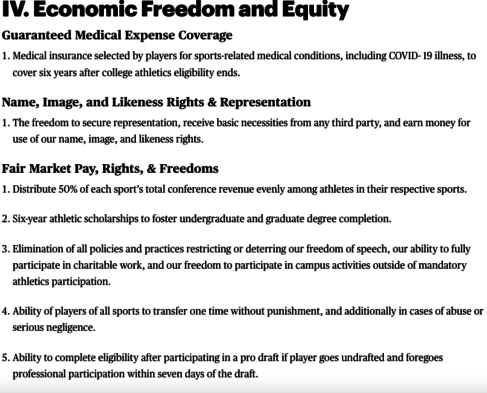
The NCAA’s worst nightmare is becoming a reality: An organized revolt by football players at big-time schools to end the long-established collective exploitation of athletes.
The argument could be made that the revolt couldn’t have been more poorly timed, when a pandemic threatens to wipe out a season of the cash cow of football. The response: The NCAA has had 114 years to reform itself, encouraged by many inside and outside to do so. It whiffed.
Let the talks begin.
A group of Pac-12 Conference players claiming to represent “hundreds” of athletes published Sunday in The Players Tribune and headlined #WeAreUnited, a document that says players will opt out of play in the 2020 season if their demands are not met regarding issues of COVID-19 safety, preserving all varsity sports, ending racial injustice and developing economic equity. (See below for details.)
The news release is signed “Players of the Pac-12,” and includes the names of 12 players representing nine of the 12 schools in the conference, including two Washington Huskies, redshirt juniors LB Joe Tryon, who led UW with eight sacks last season, and WR Ty Jones.
Here’s a list of the players on Pac-12 schools that are listed as media contacts. They are the voices of their specific campuses. None I see from Utah, USC or Colorado. Jevon Holland is biggest name, a potential first-round pick. pic.twitter.com/czS57DDJg9
— Pete Thamel (@PeteThamel) August 2, 2020
“We are being asked to play college sports in a pandemic in a system without enforced health and safety standards, and without transparency about COVID cases on our teams, the risks to ourselves, our families, and our communities,” the statement read. “We will opt-out of Pac-12 fall camp and game participation unless the following demands are guaranteed in writing by our conference to protect and benefit both scholarship athletes and walk-ons.”
The Pac-12 announced Friday its plan for a 10-game conference season starting Sept. 26, pending developments with the spread of the virus. But six of the 12 schools are in two states, California and Arizona, where infections are rampant. When news broke Saturday of the protest, the conference, which said it had not received any statement or information directly, put out a mushy, non-specific response.
“We support our student-athletes using their voice, and have regular communications with our student-athletes at many different levels on a range of topics,” it said. “As we have clearly stated with respect to our fall competition plans, we are, and always will be, directed by medical experts, with the health, safety and well being of our student athletes, coaches and staff always the first priority.”
— Elijah Molden (@e_mold3n) August 2, 2020
However, Pac-12 Commissioner Larry Scott said in May that sports would not go on this fall if students were not attending classes in person. But as school after school unrolled plans for limited or no in-person instruction, the conference appears to be slip-sliding on Scott’s commitment about wanting students on campus. Players rightly want to know what to believe from their overlords.
Washington State earlier said all undergraduate courses will be taught remotely “with extremely limited exceptions for in-person instruction.”
How is a campus unsafe for regular students but OK for the football entertainers?
While it’s true that Pac-12 athletic departments have reported few confirmed cases of positive tests upon intake — Jon Wilner of the San Jose Mercury News reported July 21 that there were 28 positives from more than 1,300 tests administered (2.16 percent), including sports other than football — six schools are not reporting any results. That’s why one of the players’ appeals was for transparency.
And there is no part of the Pac-12 safety protocol that includes a bubble existence of weeks for the pro leagues like the NBA, WNBA and NHL. Most UW players live in off-campus apartments around Seattle, where confirmed cases continue on an upward path.
WSU redshirt junior DL Dallas Hobbs told ESPN that players still want to play but are looking for solutions.
“We were hoping by fall camp (that) this stuff can kind of be sorted out,” Hobbs said. “The main thing is, the COVID concern isn’t something we want to be negotiated. The other stuff is definitely a lot to handle, and it’s definitely going to take time to negotiate. But we kind of want this process to just start and see the Pac-12 take leadership and enforce some of these standards and enforce some of these rules to just help us out in a way.
“I believe we need the basic rights and benefits that will help our future. We are all grateful for what we have but there is so much more that would create generational change.”
It isn’t clear how many athletes support #WeAreUnited, and whether there are others who aren’t agreed about a mass opt-out. Nor is it known with whom the Pac-12 would negotiate to reach any compromise on the demands.
Those difficulties are typically how the NCAA and its schools get away with exploitation — footballers start out mostly as scared teenagers grateful for the opportunity and have neither the desire nor the time to organize a challenge to the colossus of big-time college sports. And they fall under the jurisdiction of coaches typically paid millions, who dominate the kids’ fates over four years to preserve the status-quo of a system that enriches the coaches.
But there is no longer a status quo — a global public-health disaster combined with global protests over systemic racism, both of which have contributed to a crashing of the U.S. economy, have severely disrupted big-time sports.
The disease and the money crisis have disproportionately impacted Black families, whose sons occupy the majority of roster spots in big-time football. Sports enterprises are desperate to return to business, and need the cooperation of players to assume greater health risks.
Despite several attempts, a union has failed to materialize to protect college players’ workplace interests, partly because the entire workforce turns over every four years. Nor is arbitration or litigation a cheap, easy tool to resolve grievances for college kids.
But the chaos has finally provided players with some spontaneous leverage.
“They see all of this clearly through the lens of racial justice,” Ramogi Huma, the founder of a college athlete advocacy group called the National Collegiate Players Association, told ESPN. He said the players reached out to him a little more than a month ago because they did not feel there was enough being done to ensure safety.
“Right now it’s clear that the conferences don’t need the NCAA. Each conference is an industry unto itself,” Huma said. “(The players are saying) we’re fine if our conference doesn’t belong to the NCAA at all. We need to be treated fairly.”
Weighing in on the list of demands:
The COVD-19 safety issues are no-brainers. The Pac-12 should agree. Reports nationally said that some schools were asking some players to sign waivers absolving the program of liability regarding the virus, which was unconscionable. A spokesperson for Huskies athletics said no waivers were requested from UW players.
Regarding the demand that all varsity sports programs be preserved by cutting the pay of Scott and coaches, that sounds noble and fun, but the players have no standing to make that request. Salaries are determined by administrators and the marketplace, not players. And endowments are funds received for specific purposes and not subject to re-purposing.
Regarding advancing the cause of racial justice, addressing the issues in a formal way is another no-brainer. But the two-percent diversion of revenue to fund Black-community solutions sounds fraught with peril for all. Not a hill to die on.
Regarding economic freedom and equity, some of the proposals are already underway, and the protest threat could hasten arrival. What is truly wacky is the idea of taking 50 percent of television revenue and distributing it “evenly among athletes in their respective sports.” This isn’t MLB, NFL or NHL — yet. The complete professionalization of college athletics is an aspirational goal, which requires a business reformation whose time has not come — certainly not by mid-August. But six-year scholarships and a one-time transfer without punishment? Overdue.
Overall, the Pac-12 players should be commended for the effort to use the new-found leverage to gain traction for themselves and future athletes in pushing back against the colossus.
Undoubtedly #WeAreUnited has created a giant WTF in the thought bubbles above the heads of Scott, presidents and administrators. But that’s the consequence of dithering about installing storm windows when the Cat-5 hurricane has pulled into the driveway.
#WeAreUnited DEMANDS OF PAC-12 CONFERENCE




27 Comments
The perfectly written question for the moment. How, indeed?
I assumed in May that Larry Scott never wanted to be in the position of having to answer it. But no . . .
I actually believe that he doesn’t want to be in that position. But his knee-genuflect response to the people for whom he works just destroys any shred of credibility he ever had. If he were smart (and I have no idea if he is), he’d take this opportunity to get a golden parachute and go.
He’s been encouraged o go by many, bu I wonder whether presidents have so many fires to put out that they have little time for football silliness.
College football pays for all the other college sports,
to bad it can’t pay for all the student debt too..
If it goes pro, that will be slightly more possible.
On one hand these are student athletes not professional. On the other they have the right to be heard and their concerns are valid. How can they not have concerns when half the conference are in states with high COVID19 numbers? And that standards are different state-to-state and in some instances even city-to-city? It seems they’re being advised however and I wonder if the PAC-12 will investigate that angle. Being student athletes they sure seem unionized in their actions and I doubt Larry Scott will just accept things as they are.
Seems as though neither will WSU as Bleacher Report issued a story that WSU WR Kassidy Woods was told by Coach Nick Rolovich to clear out his locker and kicked off the team chat after telling the coach he was part of the group of athletes who issued the demands. If the NCAA remains quiet and let’s each conference set their own rules and standards the PAC-12 could end up losing their student athletes to other conferences. Some of the demands outlined won’t happens but some make sense. Common ground needs to be found in this.
“On one hand these are student athletes not professional.” I beg to differ a little, especially in consideration of how much revenue they generate and the # of hours they put in over the entire year.
When figuring the dollars generated, one has to use a B instead of an M in the revenue column.
I hope and think you are right about the common ground part. Now’s the time in spite of the virus.
They are professioanal. Just poorly paid.
As I wrote, Ramogi Huma, an ex-UCLA LB, is the the organizer. He’s been a longtime agitator for college player rights, and perhaps his time has come. There’s no rules violation for him or others giving free advice. But the Power 5 conferences are right to feel threatened by the P12 insurrection and want it crushed.
Regarding Rolovich’s screw-up — it was the Dallas Morning News who received the recording of his phone call threatening Woods — he overreached big-time. He backtracked his remarks yesterday, but he’s in line for a wrist-slap.
Any idea how the call was recorded without Coach Rolovich’s knowledge? IMO that’s not cool and would never be admissible in a legal case.
I generally agree with your analysis, Art. The Covid-related stuff is a no-brainer, and frankly throws some of the exploitative aspects of college football into stark relief. So, too, do the economic demands, although those are a bridge too far at this point, as at least one player you quote seems to concede. The issue of “standing,” however, doesn’t bother me as much as it seems to bother you. There is no collective bargaining agreement here, and there is no case that’s been filed. “Standing” is a legal issue, and this is not (yet) a case in court. The operative word here, instead, is “power.” The players’ collective threat gives them the power to withhold their services if their demands are not met, and the consequences of them doing so would of course be catastrophic for the university budgets involved. There’s quite a bit of leverage in that, although a true war on these economic issues now would cause damage to all concerned, not just the universities….
I get your legal point about the term standing, but in general usage it means they have no place in setting salaries. It’s like me stepping into a personal argument between siblings about their family. Even if I may care about the outcome, I have no standing.
The only way the players have any hope is a group move, because a few players or a few schools will be crushed. The #WeAreUnited hashtag was important to make sure the P12 takes the threat seriously. Indeed it was a power move.
Let me re-iterate / re-phrase some point(s) I made in an earlier post. As of this writing, no student-athlete organizations in other conferences have proposed a solution this radical. The PAC-12 doesn’t operate in a vacuum – they compete with other conferences both on the field and for athletes that comprise “the product” of NCAA athletics. Changes like this would only work if voluntarily universally adopted by all NCAA Division I conferences. It is naïve beyond belief to this will happen. Do you really expect the SEC to voluntarily embrace these changes, with their administrators and athletes holding hands at the 50-yard line enthusiastically belting out a chorus of L’Internationale?
For the PAC-12 to acquiesce to these demands (actually just the 50 percent revenue sharing and associated severe reduction in coaches salaries) would be to unilaterally disarm in the Cold War world of intercollegiate athletics. Quality coaches would leave and not be replaced. Which means star-athletes would transfer out and recruits would sign with other conferences where they can be properly coached-up to achieve their professional aspirations.
Once that happens quality of play will obviously suffer. PAC-12 schools will be routinely slaughtered by much-higher caliber programs in the Big-10, Big-12 and SEC. At which point the PAC-12 will be forced to disassociate with the “Power Five” conferences and thus become essentially an FBS-aligned conference. West coast college-sports fans – a fickle and diffident bunch at best – will then lose interest. Who would care about that all-important playoff game against Eastern Washington when you have an NCAA football championship trophy in your hall of fame? At that point attendance drops, TV viewership and all the associate revenue declines dramatically, and PAC-12 programs will be forced to shut down. And the enlightened cadre of PAC-12 athletes will get their wish – a 50% revenue split times zilch revenue.
To be clear the proposals regarding ending racial injustice, medical coverage, COVID 19 safety, 6-year eligibility, freedom of speech, freedom to transfer, and the right for non-drafted players to return to their programs are spot on. This should help eliminate the indentured-servitude environment that currently enslaves college athletes. While these changes are certainly right and justifiable no other conference will voluntarily the 50% revenue split. At the national level the PAC-12 is already a grotesquely sub-standard product to begin with. Why would other conferences agree to a business model adopted by their weakest link? My changes to the PAC-12 players proposals would be as follows:
1. Eliminate the 50% revenue split. Grant all scholarship players a monthly stipend of $1,000 per month. This would be a burden to current athletic department budgets; let each school figure out where it will come from (most likely coaches salaries).
2. Player eligibility would still be capped at five years, but allow scholarships to be maintained for seven years or until player graduates, whichever comes first.
3. Allow players to seek outside employment during school year and receive compensation in the from advertising, use of likenesses, etc. 50% of advertising compensation to be directed to fund specifically dedicated to betterment student-athletes (counseling, etc.)
4. Eliminate alumni donations specifically directed to athletic department budgets.
The only problem – if this movement is not adopted voluntarily at the national level (it won’t be), the only way to implement it would be via the court system. Which means the U.S Supreme Court, and any decision from the Supremes would in no way, shape, or form resemble the wisdom of Solomon. They would most likely throw up their hands, probably resulting in a pure revenue model where players could receive revenue they directly generate from their specific sport. You want free enterprise – well guess what you’ve got it. With the possible exception of women’s basketball, you can say goodbye to men’s/women’s golf, baseball/softball, soccer, gymnastics, track etc. Guess which gender comes out on the short end of this new-found “freedom”?
What we’re really talking about the dismantling of the NCAA. Perhaps a historical analogy is appropriate. While the former Soviet Union (NCAA) was a tyrannical, corrupt regime, it nevertheless in a perverse way create a sense of order. When it fell people hailed its demise and the hope for freedom and economic opportunity that ensued. In reality, though only chaos and corruption followed. Some Russians took advantage of this by opportunistically morphing from apparatchiks to oligarchs and became fabulously wealthy in the process. Most Russian peasants though – given a lifetime of dependence and servitude to their government and it system – were ill-equipped to take advantage. To them it just meant shortages, higher prices and more suffering. The oligarchs of the Big Ten and SEC will survive and flourish regardless. God help the rest of the helpless peasants. Perhaps its better to reform rather than abolish the tyrant..
Be careful what you wish for.
Quite the essay, puck. I don’t think any of us should take seriously the 50% rev split, nor its sharing of revs among athletes. That had to be a throw-in that they could say they “sacrificed” in negotiations.
But the consistent undercutting of the NCAA’s governance over the Power 5 conferences could bring about a massive change. Keep in mind that the NCAA is more of a trade association to promote the industry. You know, like the Dairy Farmers of Washington. The NCAA is a big help to the FCS/DivII.DivIII by organizing national tournaments and making sure the baskets are 10 feet. But the NCAA is less of a player every year when it comes to Power 5. The conferences control the FBS playoffs and all the bowls.
The biggest influencer of all is COVID-19. Expect to see wholesale shutdowns of sports programs throughout the lower ranks, massive layoffs in D1 and dozens of smaller campuses closing forever.
College football is the NFL’s minor leagues and should be treated as such. All cost related to college football should be born by the NFL including player salaries. Thank Mariners and the Everett aquasox, as and AAA teams.
What I was hopeful the XFL would turn into. Let kids who want to get paid to go there and let others attend college.
Still could be the case, thanks to The Rock.
The vast majority of NCAA players never make it to the NFL (less than 1% across all divisions)….But, the vast majority (less than 10%) of minor league baseball players never make MLB. That is why MLB is looking to reorganize the player development system.
The Mariners purge in the scouting department is due largely to the availability of data that is more helpful than human scouting.
One of the reasons the NFL is such a colossus is the free farm system. The financial damage to sports by COVID 19 will be felt most deeply in athlete development across all sports.
I am old enough to recall a famous photo of the 60’s of student anti-war protesters shutting down the Princeton campus and sitting in the President’s office. It was a great photo op, but their occupation was brief. In the end, those in power pushed back HARD to resume life as it had been. With TV, streaming, radio, sponsors, ticket sales, suites, merchandise and the institutions themselves, Pac 12 sports are a billion dollar enterprise that can push back mightily to 20 year olds. I wish the kids well.
The turnover in the labor force is what keeps the enterprise free from being undercut. Only when Ed O’Bannon has the will to see it through to a court win many years after he left UCLA, is justice brought to bear.
I say good for them. They aren’t getting paid yet (allowed by the NCAA I mean). If they show up they will be under constant pressure to keep quiet and go with the flow. Yes I understand that athletic scholarships are worth a lot of money but it’s not money in the pocket like the pros get. Understand it will hurt athletic departments and colleges as a whole across the country but the season should be canceled.
Keeping quiet is a big deal for college sports programs. Boat rockers are a threat to an economically fragile enterprise.
Good for them. Also, overplaying your hand is a feature of being under 22. I wish them the best, but also wonder if the Pac-12 is just going to try and run out the clock on them. I’m skeptical football is happening this year at any level, and a pretty easy way to deal with ‘malcontents’ is to still take a year of eligibility regardless of the season happening. Losing 25% of your career to make a point, and maybe the entirety of your time of actually getting on the field, is a tough ask.
I don’t think P12 is going to punish anyone for a group protest. It’s standing up alone that gets a kid in trouble. And they saw the leverage the NFL and NBA players have. Of course they overreached, but that’s a way to get most of what you really want.